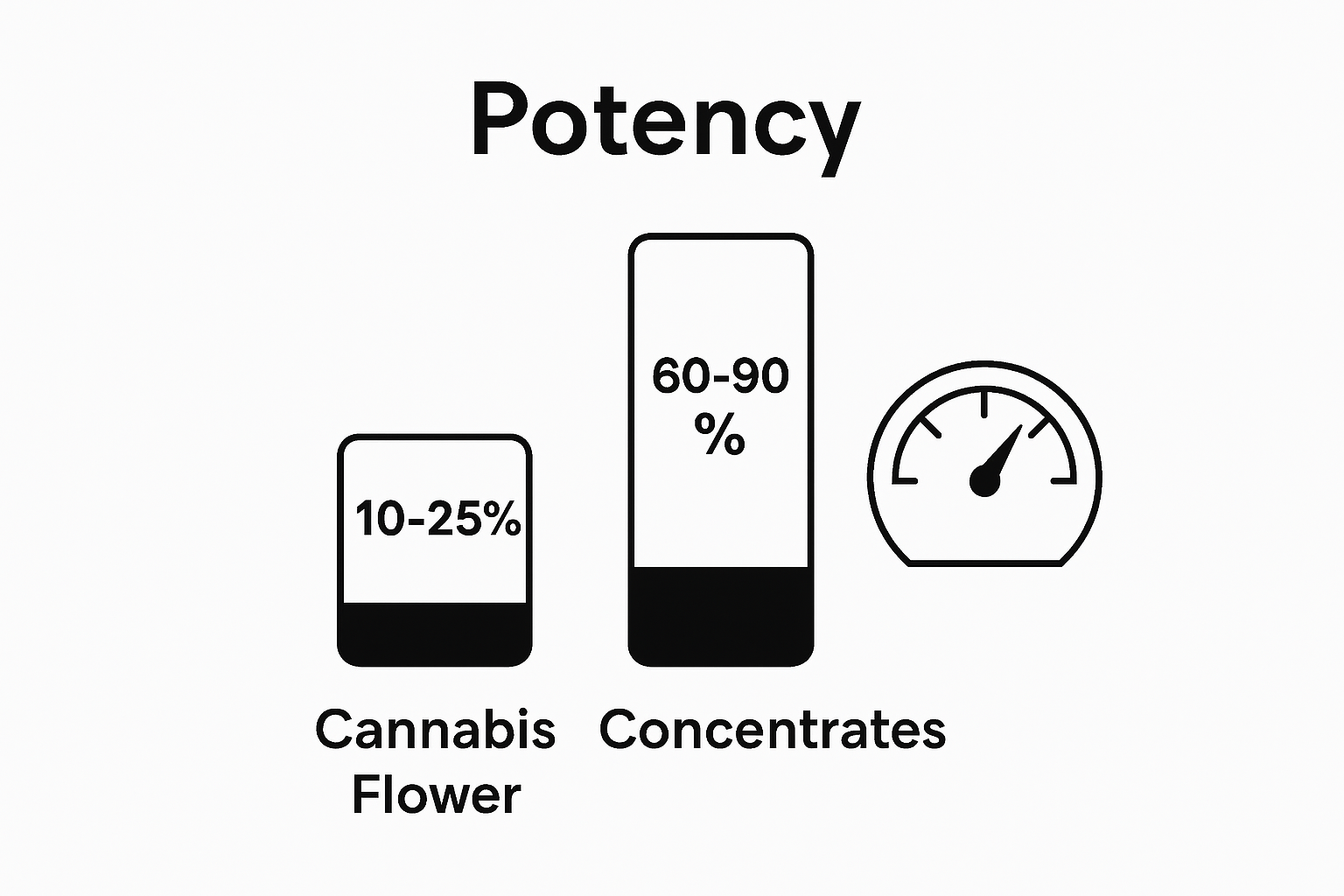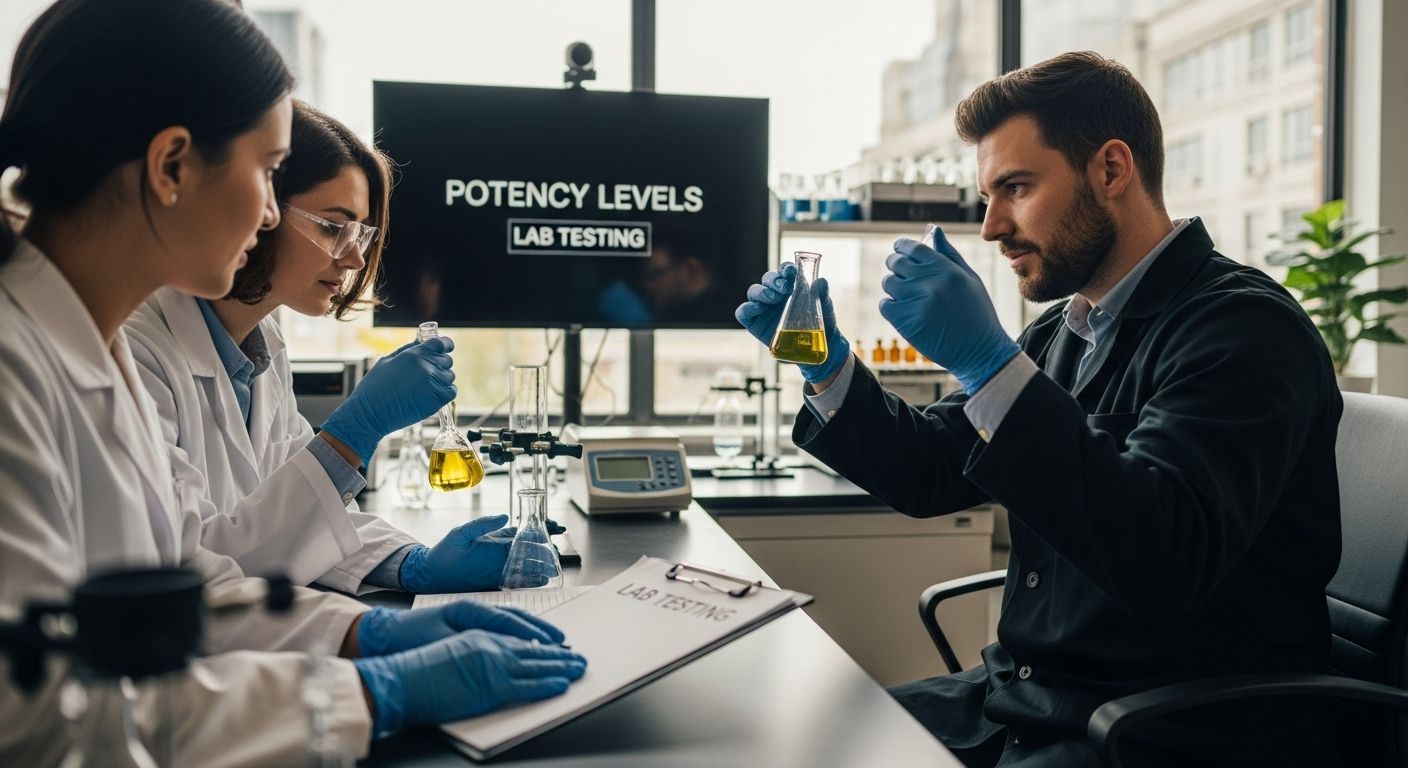Blog
What is THC Potency? Understanding Cannabis Strength
THC potency shapes how cannabis feels and what it actually does for your body and mind. Cannabis flowers and concentrates can hit wildly different strengths, with some extracts pushing as high as 90 percent THC. Most people expect the bigger numbers mean just a stronger high but that is not always the case. The most surprising thing is how THC concentration changes everything from therapeutic effects to personal tolerance and even safety risks.
Table of Contents
- Defining THC Potency: What It Means
- The Importance of THC Potency in Cannabis Products
- How THC Potency Affects the Experience
- Key Concepts and Factors Influencing THC Potency
- Understanding Lab Testing and Potency Measurement
Quick Summary
| Takeaway | Explanation |
|---|---|
| Understand THC potency levels | THC potency indicates the concentration of THC in cannabis products, influencing their effects. |
| Higher potency equals stronger effects | Products with higher THC percentages can result in more intense psychoactive experiences, suggesting careful dosage management. |
| Individual tolerance varies significantly | Each person’s response to THC can vary based on prior experience and personal physiology, emphasizing the need for cautious consumption. |
| Genetics and cultivation impact potency | The THC concentration in cannabis is determined by genetic strains and environmental factors during cultivation, affecting product strength. |
| Know testing methods for accuracy | Cannabis potency testing uses advanced techniques to measure THC accurately, ensuring consumers receive reliable information about product strength. |
Defining THC Potency: What It Means
THC potency represents the concentration of tetrahydrocannabinol (THC), the primary psychoactive compound in cannabis that determines the strength and potential effects of a cannabis product. Understanding THC potency is crucial for consumers seeking predictable and controlled cannabis experiences.
The Science Behind THC Concentration
At its core, THC potency measures the percentage of THC present in cannabis flower, concentrates, or manufactured products. Most cannabis products range from 10% to 30% THC concentration, with some specialized extracts reaching up to 90% potency. The higher the percentage, the more intense the potential psychoactive and therapeutic effects.
According to the National Institute on Drug Abuse, THC potency has significant implications for both recre
This table summarizes the main factors that influence THC potency in cannabis products, highlighting how each aspect affects the final strength and effectiveness experienced by consumers.
| Factor | Role in THC Potency |
|---|---|
| Genetic Strain | Determines inherent cannabinoid potential |
| Growing Conditions | Impacts cannabinoid synthesis and yield |
| Cultivation Techniques | Optimization can maximize potency |
| Extraction & Processing Methods | Influence concentration in extracts |
| Storage & Preservation | Proper care maintains potency over time |
ational and medicinal users. Key factors influencing THC concentration include:
- Genetic strain of the cannabis plant
- Growing conditions and cultivation techniques
- Extraction and processing methods
- Storage and preservation of cannabis products
Understanding Potency Variations
Cannabis potency is not uniform across different product types. Flower (traditional cannabis buds) typically ranges between 10% to 25% THC, while concentrates like wax, shatter, and oils can reach 60% to 90% potency. This dramatic variation means consumers must be exceptionally careful when selecting and consuming cannabis products.
To clarify the different types of cannabis products and their typical THC potency range, the following table organizes key product categories with their associated strengths and experiential notes.
| Product Type | Typical THC Potency Range | Description/Experience |
|---|---|---|
| Flower (Buds) | 10% – 25% | Traditional form; offers balanced to moderate effects |
| Concentrates (Wax, Shatter, Oils) | 60% – 90% | Highly potent; produces intense psychoactive effects |
| Edibles | Varies (Infused with Extracts) | Effects depend on extract used and dosage |
| Pre-rolls | Typically matches flower | Ready-to-use; effects align with flower’s potency |
| Tinctures & Oils | Variable (Broad Range) | Measured doses; suitable for controlled consumption |

The potency level directly correlates with the potential intensity of effects. Lower potency products might produce mild relaxation or subtle mood changes, while high-potency products can induce strong psychoactive experiences, potentially causing anxiety or disorientation in less experienced users. Responsible consumption requires understanding these nuanced differences and selecting products aligned with individual tolerance and desired outcomes.
To help readers understand how THC potency relates to both desired outcomes and potential risks, the following table compares effects and considerations for low versus high potency products.
| THC Potency Level | Typical Effects | Considerations for Use |
|---|---|---|
| Low (10%-15%) | Mild relaxation, gentle mood elevation | Suitable for beginners; lower risk of adverse reactions |
| Moderate (16%-30%) | Noticeable psychoactive effects, enhanced euphoria | Requires some tolerance; monitor dosage |
| High (60%+) | Intense psychoactivity, possible anxiety/paranoia | For experienced users only; greater risk of overconsumption |
The Importance of THC Potency in Cannabis Products
THC potency serves as a critical metric for understanding the potential effects, safety, and therapeutic value of cannabis products. More than just a number, potency represents the comprehensive interaction between chemical concentration and user experience.
Medical and Recreational Implications
THC potency directly influences the physiological and psychological impact of cannabis consumption. For medical patients, precise potency allows for targeted symptom management, enabling careful dosage control for conditions like chronic pain, anxiety, or sleep disorders. Recreational users rely on potency information to predict and moderate their potential experience.
According to research from the National Institute on Drug Abuse, THC concentration has significant implications for consumer safety. Important considerations include:
- Potential risk of overconsumption
- Variation in individual tolerance levels
- Differential effects based on consumption method
- Long-term neurological impacts
Risk Management and Consumer Education
Understanding THC potency is fundamental to responsible cannabis consumption. Higher potency products require more nuanced approach and potentially greater user experience. New consumers should start with lower potency options, while experienced users might seek more concentrated products.
The dramatic increase in cannabis potency over recent decades underscores the need for comprehensive consumer education. Learn more about our guide to cannabis product testing to understand how manufacturers ensure accurate potency labeling and consumer safety.
Ultimately, THC potency represents a complex interplay between chemical composition, individual physiology, and intended use. Informed consumers make better choices, prioritizing personal well-being and understanding the subtle yet significant differences in cannabis product strengths.
How THC Potency Affects the Experience
The potency of THC dramatically shapes the cannabis consumption experience, influencing everything from immediate physiological responses to long-term neurological interactions. Understanding these nuanced effects helps consumers make informed decisions about their cannabis use.
Physiological and Psychological Responses
THC potency directly correlates with the intensity and duration of cannabis effects. Lower potency products typically produce mild, manageable experiences, while high-potency cannabis can trigger profound psychological and physical responses. The concentration of THC determines how quickly and intensely cannabinoid receptors in the brain and body are activated.
According to research from the National Institute on Drug Abuse, THC concentration significantly impacts user experience through several key mechanisms:
- Rapid onset of psychoactive effects
- Potential for increased anxiety or paranoia
- Enhanced sensory perception
- Alterations in cognitive processing
- Modulation of pain and stress response
Individual Variability and Tolerance
Each person’s response to THC potency varies based on individual physiology, previous cannabis experience, and metabolic factors. New users or those with lower tolerance are more susceptible to intense effects from high-potency products. Explore our comprehensive guide on understanding strain selection to learn how different cannabis varieties impact personal experiences.
Experienced consumers often develop higher tolerance, requiring more potent products to achieve similar effects. This biological adaptation underscores the importance of responsible consumption and gradual dosage exploration. The complex interaction between THC concentration and individual biochemistry means that potency is not a one-size-fits-all measurement, but a personalized experience that demands careful consideration and self-awareness.
Key Concepts and Factors Influencing THC Potency
THC potency emerges from a complex interplay of genetic, environmental, and cultivation factors. Understanding these intricate dynamics helps consumers and producers comprehend how cannabis strength is fundamentally determined and optimized.
Genetic and Botanical Influences
Cannabis genetics play a pivotal role in determining THC concentration. Different cannabis strains possess inherently varied genetic profiles that predispose them to produce specific levels of cannabinoids. Sativa, indica, and hybrid varieties exhibit unique characteristics that directly impact their potential THC content.
According to research from the National Institute on Drug Abuse, multiple critical factors contribute to THC potency:
- Genetic lineage and breeding history
- Specific cannabinoid receptor variations
- Inherent plant metabolic capabilities
- Potential for genetic manipulation
Environmental and Cultivation Dynamics
Beyond genetics, environmental conditions significantly influence THC production. Factors such as light exposure, temperature, humidity, soil composition, and nutrient availability can dramatically alter cannabinoid synthesis. Cultivators meticulously control these parameters to optimize THC concentration.
Learn more about specialized strain characteristics to understand how precise agricultural techniques impact cannabis potency. Indoor cultivation allows for unprecedented control over growth conditions, enabling producers to create consistently high-potency cannabis through strategic environmental management.
The interaction between genetic potential and environmental optimization represents a sophisticated process of cannabis potency development. Successful cultivation requires understanding these nuanced relationships, transforming cannabis production from a simple agricultural practice to a sophisticated scientific endeavor.
Understanding Lab Testing and Potency Measurement
Lab testing represents the critical scientific process that transforms cannabis from an unverified product into a precisely measured and reliably quantified substance. These sophisticated analytical techniques provide consumers and regulators with accurate insights into THC concentration and overall product quality.
Advanced Analytical Techniques
Cannabis potency testing utilizes advanced chromatography and spectroscopy methods to precisely measure THC content**. High-performance liquid chromatography (HPLC) and gas chromatography serve as primary techniques for isolating and quantifying cannabinoid concentrations with remarkable precision**. These scientific approaches enable researchers to break down complex cannabis samples into their fundamental chemical components.
According to research from the National Institute on Drug Abuse, laboratory testing involves several critical measurement protocols:
- Precise sample preparation techniques
- Multiple analytical verification stages
- Standardized calibration of scientific instruments
- Comprehensive cannabinoid profile assessment
- Statistical validation of results
Quality Control and Regulatory Compliance
Modern cannabis testing goes beyond simple potency measurement. Explore our comprehensive guide to cannabis product testing to understand the intricate processes that ensure consumer safety. Laboratories perform extensive screenings for potential contaminants, including pesticide residues, heavy metals, and microbial impurities.
The rigorous nature of cannabis potency testing reflects the industry’s commitment to transparency and consumer protection. By implementing standardized measurement protocols, laboratories transform raw cannabis into a scientifically validated product, providing consumers with reliable information about strength, purity, and potential effects. This meticulous approach bridges the gap between agricultural production and responsible consumer consumption.

Ready to Take Control of THC Potency?
Understanding THC potency is key to having a safe and enjoyable cannabis experience. The article explores how potency affects your choices and highlights the importance of verified information, so you do not risk overconsumption or unpredictable effects. At Puff Laco, we know that selecting the right product strength can feel confusing, especially with so many options available.
.png)
Make smarter, more confident purchases by shopping with a brand that puts authenticity, reliability, and strict quality testing first. Every product on Puff Laco is tested for potency and purity, with clear descriptions of cannabinoid profiles. Want extra peace of mind before you buy? Explore our cannabis product testing process or dive deep into strain selection and effects to find the perfect match for your needs. Do not wait—the right potency for your lifestyle is just a click away.
Frequently Asked Questions
What does THC potency mean in cannabis products?
THC potency refers to the concentration of tetrahydrocannabinol (THC) in cannabis products, indicating the strength and potential effects of the product. It is typically expressed as a percentage and can range from 10% to 30% for flower and up to 90% for concentrates.
How does THC potency affect the user experience?
Higher THC potency generally leads to more intense psychoactive effects. Low potency products may cause mild relaxation or mood changes, while high potency products can induce strong effects, including anxiety or disorientation in inexperienced users.
What factors influence THC potency in cannabis?
THC potency is influenced by several factors, including the genetic strain of the cannabis plant, growing conditions, cultivation techniques, extraction methods, and how the product is stored.
Why is it important to understand THC potency when using cannabis?
Understanding THC potency is crucial for responsible cannabis consumption. It helps users select appropriate products based on their tolerance levels and desired effects, ensuring a safer and more predictable experience.
Recommended
- Understanding What Are Flavor-Specific Strains
- Understanding the Role of Strain Selection in Cannabis
- Master the Cannabis Product Testing Process in 2025
- What is a Vape Cartridge? Understanding Its Role and Function

